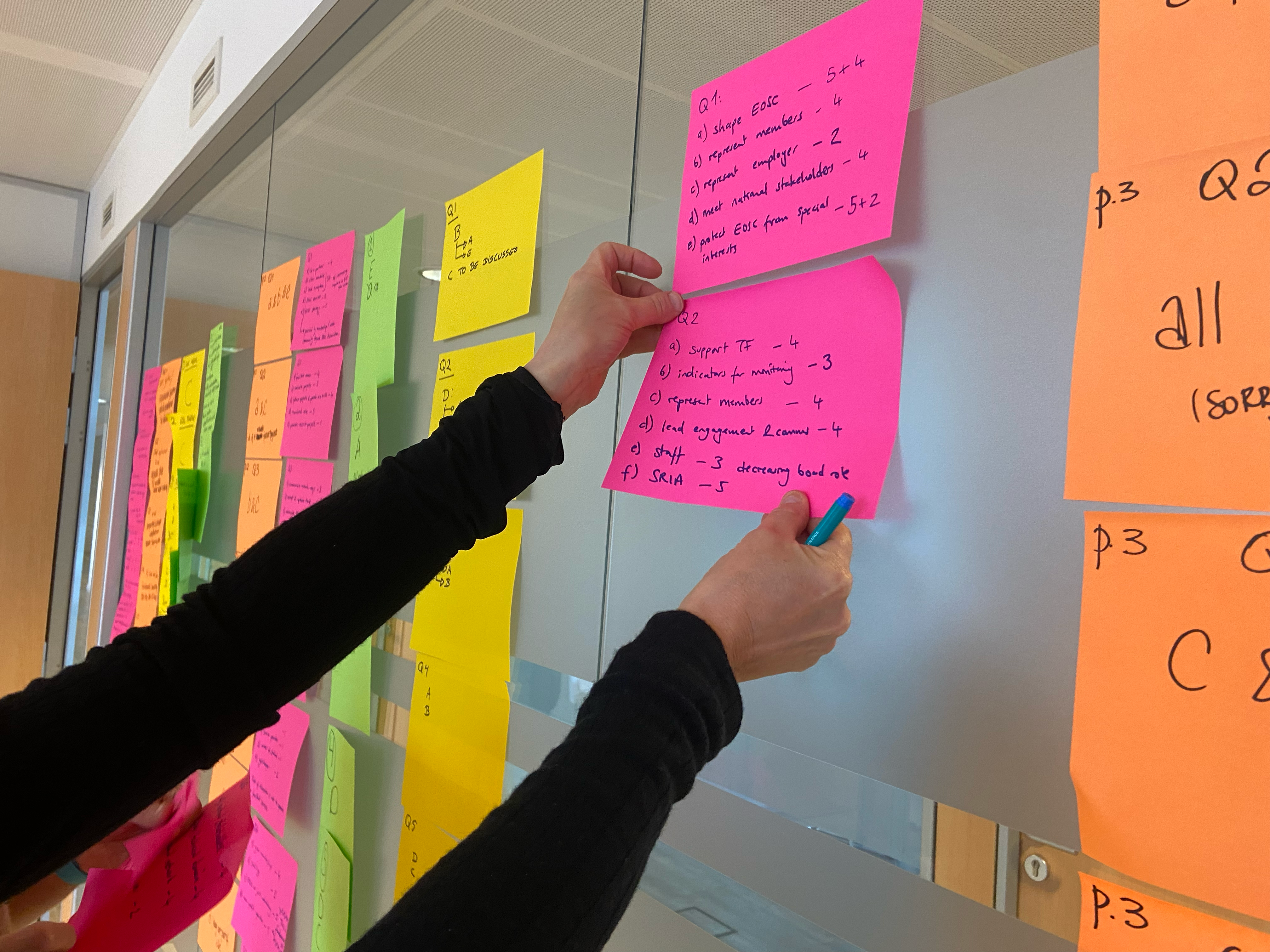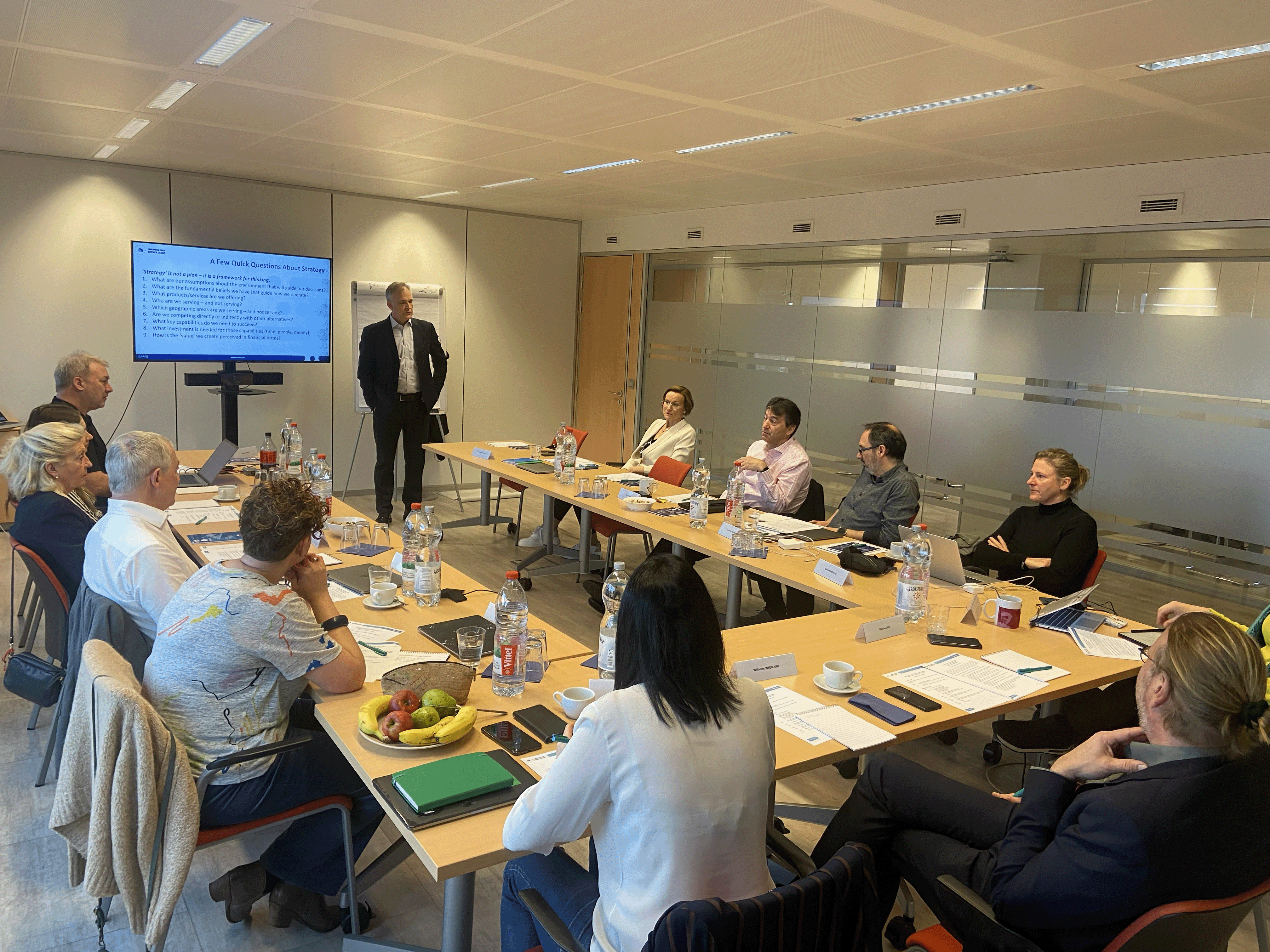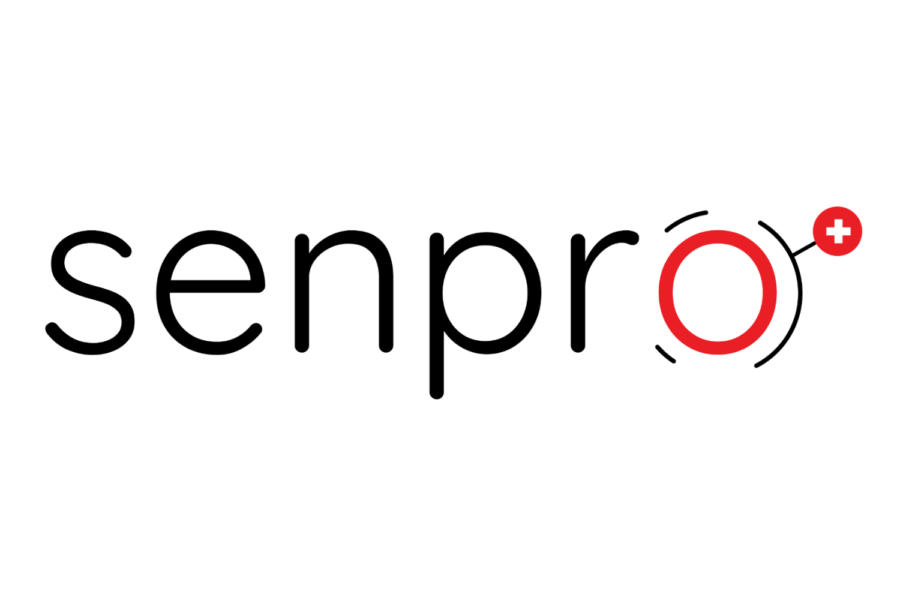Following two years of informal Friday meetings and half a dozen formal ones, the EOSC Association Board of Directors finally met in person in Brussels over two days on 12-13 April 2022. Given the extraordinary circumstances, and the fact that many on the Board had never met one another in person, the meeting began with the social programme on Tuesday evening before gearing up for a full- day strategy workshop on Wednesday.
“Though Ute [EOSC-A Secretary General Ute Gunsenheimer] lamented the fact that our dinner was the only thanks we got for nearly two years of hard work, the positive spirit coming from every corner showed that the Board and Secretariat didn’t need special appreciation,” said Board member Sarah Jones of GÉANT.”
It was heartening to see how easily everyone got on like old friends, and that Board members were there for the right reasons. When asked in the workshop about what motivates us to serve, answers were unanimously focused on the drive to shape EOSC, and showed that we recognise being elected to the Board is a privilege.”
The strategy workshop – expertly led by Allen Weeks, director-general of the Extreme Light Infrastructure (ELI ERIC) – was structured around a three-part questionnaire that all EOSC directors were asked to completed anonymously in advance. The questionnaire was designed to test the assumptions of the Board and to initiate a process of reflection across the full membership of the EOSC Association. Each session presented a series of open questions on the role of the Association and its objectives over the next three to five years:
- How to realise the vision of EOSC?
- The Mission of the EOSC Association
- The role of the EOSC Association Board and Members
The results of the questionnaire, which were expertly analysed and presented for the meeting, were first discussed in groups of three to four that included both Board members and Secretariat staff. These groups then came back to share their ideas in plenary and open the discussions to the larger group.

The workshop touched on several topic areas central to the implementation of EOSC, and a number of ideas moved closer to consensus within the Board. Each warrants further exploration, and the following summary statements are presented to encourage feedback and reflections from the EOSC-A member base, as well as to publicly indicate the direction of the Board’s thinking.
“There was a palpable level of goodwill and momentum which we intend to build on,” said the Board’s Chair and President of the EOSC Association Karel Luyben. “The Board will be scheduling quarterly strategy sessions to enable us to have more face-time to work through emerging issues and maintain good working relations. As always, such exercises are meant to encourage the EOSC membership to reach out to us, via the Secretariat or via Board members individually. We’re an approachable bunch, and as the workshop showed we’re all dedicated to driving the best result for the end users.”
Key outcomes and summary statements from the April 2022 EOSC-A Strategy Workshop:
- EOSC should be a centrally coordinated but distributed system.
- The community-driven, bottom-up methodology is important to enable multiple stakeholders to contribute and feel a sense of shared ownership. We recognise the challenge of making this a reality given the very large and diverse set of stakeholders in the EOSC community.
- EOSC requires a combination of Member State and EU funding, with most elements (e.g. compute, network, operation, etc.) requiring a mixed model with different levels of funding coming from each source.
- An undefined usage-based or tariff funding model may be appropriate for certain elements such as compute (e.g. for high volumes), but a core, base level of service should be free at the point of access for European researchers.
- The EOSC Association has a clear mandate to act as an impartial coordinator of activities and help steer the direction of EOSC projects. We now need to assert this and ensure it is recognised by EOSC stakeholders.
- The EOSC Association should offer a common communication platform as well as a collaboration platform. Members have asked for the latter specifically, and this was perceived to offer higher impact than the communication platform as it delivers tangible benefits for the community.
- The EOSC Association should not operate or provide services, nor should we be a beneficiary of funding where it brings us into competition with our members. Exceptions to this are very limited cases like the forthcoming Coordination and Support Action, EOSC Focus project (a response to HORIZON-INFRA-2021-EOSC-01- 02), which will start in June 2022.
- The EOSC Association should continue to grow as a membership organisation.
- In the forthcoming five year window we should transition to (or at least significantly plan towards) an organisational structure with direct representation of Member States, such as an ERIC, EDIC or Joint Undertaking.
- The most critical stakeholder for the Association is its Members, and these must include Research Infrastructures and Research Performing Organisations or we have failed in our engagement. The Association will not engage individual researchers, but rather leverage the structures and organisations already in place. Thus, engaging such intermediaries is critical.
- Activities of the Board will become less operational (e.g. recruiting staff and administering consultations and monitoring) as we recruit more Secretariat staff. There was a desire from both Board members and the Secretariat that we focus more on strategy.
- The credibility of the Board depends on the trust of Association Members and we are fortunate that we have a team of collaborative, community-driven individuals. We must, however, continue to have transparent decision making and establish a Code of Conduct with a log of Conflicts of Interest to anticipate potential problems and to have procedures in place to deal with any that arise.
- There is a need to reach greater consensus on the definition and boundaries of EOSC and the EOSC ecosystem, as this is potentially a point of confusion within the community.





